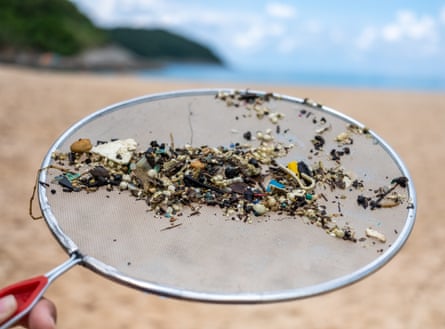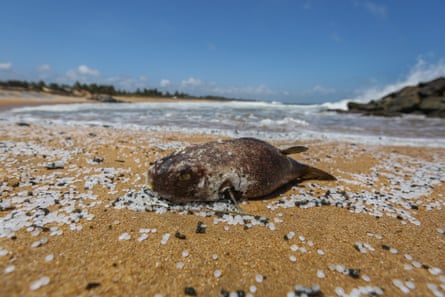In September 1993, during a beach clean on the Isle of Man, Richard Thompson noticed thousands of multicoloured fragments at his feet, looking like sand. While his colleagues filled sacks with crisp packets, fishing rope, plastic bags and bottles, Thompson became transfixed by the particles.
They were so tiny that they did not fit any category in the spreadsheet where volunteers recorded their findings. “Yet it was pretty clear to me that the most abundant item on the beach was the smallest stuff,” Thompson says.
Over the next 10 years, after completing a PhD and going on to teach marine biology at Newcastle, Southampton and Plymouth universities, Prof Thompson spent his spare time beach-hopping, often enlisting students to help him gather dozens of sand samples in tinfoil trays.
Back in the lab, they would confirm what Thompson had first suspected: the particles were all pieces of plastic, no larger than grains of sand, and ubiquitous along the UK coastline. It was pollution on a whole new scale.

“I started studying marine biology because it was going to be all about turtles, dolphins, and coral reefs,” he says. Instead, those minuscule particles became his main fascination.
In a short study in 2004, co-authored with Prof Andrea Russell at Southampton University, Thompson first described the particles as “microplastics”. He hypothesised that as plastic entered the sea, it slowly fragmented into small but persistent pieces that spread even farther afield. He did not expect much reaction from his modest one-page article.
“It had been a May bank holiday weekend, and we’d been away camping. I came back in and every email that morning was from a journalist, and the phone was ringing continuously.”

The story was picked up instantly by networks in the UK, Europe and Asia. “Shortly after it was published, it was being discussed in the Canadian parliament,” says Russell, whose experiments had confirmed that the particles were plastic.
The discovery helped spawn an entire field of microplastics research, and would be instrumental in plastic bag taxes and bans on plastic microbeads in rinse-off cosmetics in countries including the US, New Zealand and Canada.
Researchers now look at even tinier fragments called nanoplastics that infiltrate our blood, wombs and breastmilk. In some parts of the world, people consume a credit card’s worth of plastic this way each week.
As for Thompson, he would go on to be named the “godfather of microplastics” by a British politician, establish the International Marine Litter Research Unit at Plymouth and become a frequent guest at the House of Commons to discuss the dangers of marine litter.
Most recently, he has been catapulted into the heart of international negotiations to draw up a global treaty to curb plastic pollution, which had its most recent talks in Paris in June.

A UN-led plastics treaty is a “once-in-a-planet opportunity”, Thompson says, but on some of the supposed solutions being put forth, he is very clear. He is adamant that biodegradable plastic cannot save us. Neither can any amount of “cleanups”, like his own fateful expedition in 1993.
What’s worse, he thinks, is that if the plastics treaty sends the world chasing the wrong ideas, microplastics pollution will only worsen. “There’s a real risk that worries me,” he says. “That if we guess at this, we’ll get it wrong.”
A tall figure who speaks with an infectious enthusiasm despite the subject of his work, Thompson often starts conversations by checking his watch – knowing that once he gets started on plastics, time can quickly run away.
He describes his discovery as the result of a solution gone awry. Plastic was invented as a sustainable alternative to ivory, then became indispensable in fields such as engineering and medicine.
But the problem began in the 1950s when the industry’s ambitions turned to single-use packaging, which now accounts for 40% of the more than 400m tonnes of plastic produced each year – at least 8m tonnes of which finds its way to the ocean. Meanwhile, production is only increasing.
The other side to this coin is plastic’s persistence in nature. Thompson’s hypothesis was correct: microplastics result from the lengthy breakdown of larger items, and they will linger for decades more thanks to plastic’s inherent durability, all the while absorbing harmful toxins and pathogens that end up in the bodies of marine animals.
It was known that plastic waste floated in the ocean, but it was not until Thompson gave the tiny versions a name that the world finally recognised the scale of this new pollution.
“I saw [Thompson’s 2004] paper and said: ‘This is really important. Maybe people are going to wake up to the widespread abundance of plastics in the ocean,’” says Edward Carpenter, a retired marine scientist who was the first to describe floating plastic fragments on the surface of the Sargasso Sea in 1972 – particles that are probably still at sea to this day.
Thompson went on to provide the first evidence that sea creatures ingest these particles. He also showed their global distribution, including in the Arctic and in every sample of sand taken from dozens of beaches worldwide.

The plastics treaty would be a shot at stemming this flow, he notes. Much depends on the treaty’s scope, on questions such as whether it should ban some types of plastic, or regulate the array of 13,000 chemicals in everyday packaging.
What concerns Thompson is that policymakers may be led astray by much-hyped approaches that are already being used – for instance, hi-tech initiatives to remove plastic from the sea, such as the Ocean Cleanup.
Thompson stresses that he is an ardent believer in cleanups for coastal pollution, but that it is “naive to expect that [cleanups] can be a systemic solution” to the vast threat of microplastics.
“The psychologists would call it ‘techno-optimism’,” he says. “If we’re not careful, the public gets convinced that a big gadget whizzing around in the middle of the Pacific gyre is going to mop it all up for us, and that’s the end of the story.
after newsletter promotion

“It’s an attractive story – from the point of view of not having to change anything we do.”
Similarly, the proliferation of plastic alternatives such as biodegradable and bio-based plastics. “I was really curious, was this going to be an answer to the problem?” Thompson says.
But, although they are a partial improvement on the fossil-fuel footprint of conventional plastics, and may have some legitimate uses, most biodegradable plastics do not melt away into nature – a fact Thompson first realised when, early in his research career, a trawl hauled a bag up from the bottom of the North Sea. On its side was printed “biodegradable”. “I’ve still got it here somewhere!” he says, gesturing behind him at stacked shelves loaded with folders.
We now know – again, thanks to experiments by Thompson and colleagues – that many biodegradables need controlled industrial conditions to degrade, and can take years to disappear in soil and sea.
“If we keep the nearly 300-400m tonnes of plastic we’re making every year, and all we’re doing is chucking biosource plastics [which are biodegradable] to fill the gap, it doesn’t fix the problem of litter, it doesn’t fix the problem of waste, it doesn’t fix the problem of chemicals,” he says. “It’s just substituting the carbon source.”
None of these kinds of actions change what he thinks is the real danger: the linear relationship we have with plastic – produce, consume, dispose – which created the problem. After two decades describing that problem, he is now focused on the cause. “It’s very much coming back to the land, my research, because the problem isn’t made in the ocean: it’s made by practices on land.”
He said as much at the Paris talks. “Let’s turn to the solutions, which lie upstream,” he told an audience of delegates from 58 countries, explaining that in order to slow the flowing river of plastic, we first need to narrow its source. “We can’t carry on [producing] at the rate we are. It’s overwhelming any ability to cope with it.”

He agrees with new calls among treaty negotiators to curb “unnecessary, avoidable or problematic” plastics, which could include the deluge of single-use items. “I mean, surely we want to buy the product, not the packaging it’s in,” Thompson says. “I think that’s a key place to start: the most important [type of plastic] accumulating in the oceans and escaping waste-management systems is packaging.”
But while items sheathed in Russian-doll-like layers of plastic are obvious candidates for cuts, certain plastics do bring legitimate value to our lives and are likely to remain with us, Thompson says. “I’m not saying we can carry on with business as usual. Reduce has to be the first action,” he stresses – but for the plastic that remains in use, he believes the challenge is to redesign it.
Just 10% of plastic is recycled globally, a staggeringly low figure that is partly due to the thousands of chemicals that give plastic its diverse qualities, colours and forms and make it almost impossible to remix.
“We do a really bad job of designing stuff for circularity. So when people say that it’s clearly failed because we’re only recycling 10%, I think the root cause of the error is at the design stage,” Thompson says.
“When I talk to product designers, they say they were asked to design a product that was attractive – they weren’t asked to consider end-of-life.”

Like some other scientists, he believes chemical additives need to be reduced in the plastic manufacturing process, with the bonus of making them safer to use. He cites PET bottles as a good example of how simpler construction makes it possible to recycle some products up to 10 times.
Redesign can also soften the impact of plastic during its lifecycle. Take the problem of polymer-rich fabrics that shed plastic microfibres into the sea. Several countries now require filters on washing machines to capture these threads.
Yet Thompson and his team have found that half the shedding happens, not during washing, but while people are wearing clothes. Redesigning fabric for longer wear reduces shedding by a striking 80%. “So the systemic answer would work for the planet,” he says. His latest work is examining other design challenges such as car tyres, a primary source of marine microplastics.
Growing scientific consensus on these and other issues could soon be crucial in guiding nations towards solutions, so as a scientist, Thompson is frustrated that there is no UN-level mechanism to communicate the most up-to-date plastics research to governments.
In its absence, he helped establish the Scientists Coalition for an Effective Plastics Treaty, an independent, voluntary group of 200 multidisciplinary researchers from 40 countries who are filling the gap by providing scientific advice to treaty negotiators.
“Scientific evidence has brought us to this point. We’re going to need scientific evidence to go forward in the right way,” he says.
How did he feel in June witnessing nations come together to agree on the need to ban or regulate microplastics – knowing he was at least a part of the reason they were all there? Thompson takes a rare pause in our conversation. “That’s actually making me quite emotional to think about,” he says.

Weeks later, he elaborates. “A whole body of evidence brought us to where we are now with the UN treaty, and even the discussions about microplastics,” he says. “But it was quite a moving moment from a personal perspective, that I felt you could draw a line right back to that paper in 2004.”
